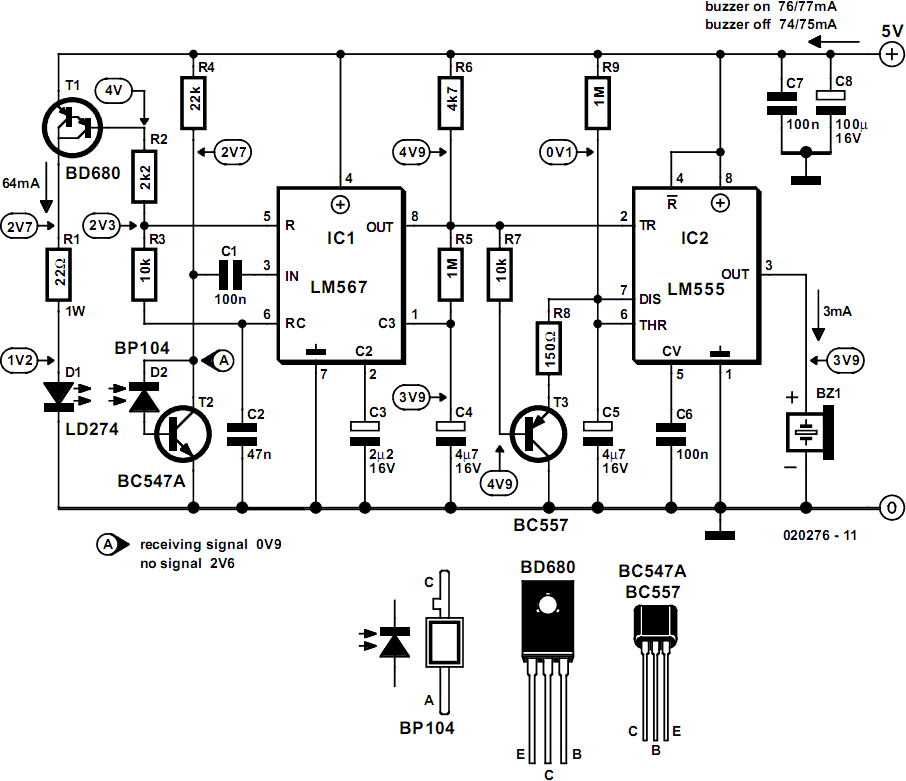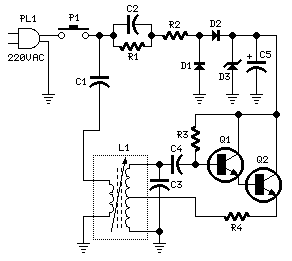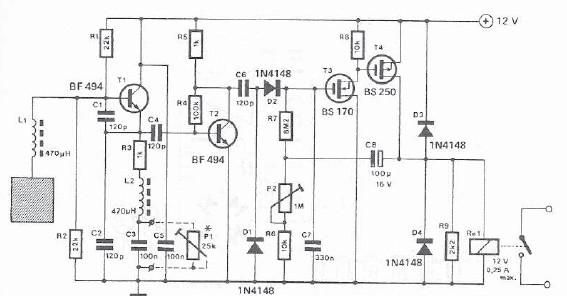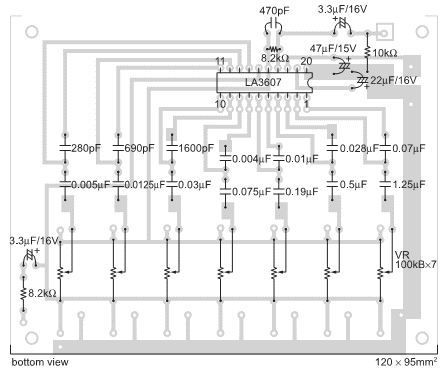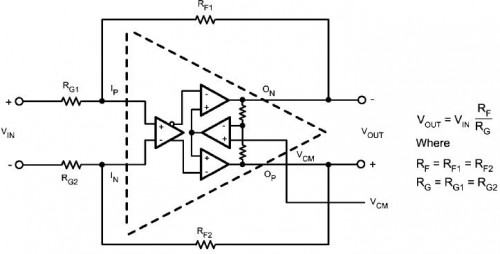
metal detector using cs209a

This metal detector utilizes the CS209A integrated circuit manufactured by Cherry Semiconductor. The CS209A is a bipolar monolithic IC designed for metal detection and proximity sensing applications. It features two on-chip current regulators, an oscillator, low-level feedback circuits, a peak detection/demodulation circuit, a comparator, and two complementary output stages. The oscillator output, in conjunction with an external LC network, generates controlled oscillations, with the amplitude significantly influenced by the quality factor (Q) of the LC tank circuit. The demodulator detects the negative peak of the oscillator waveform and produces a demodulated signal for the comparator. The comparator determines the state of the complementary outputs by comparing the demodulated input to an internal reference voltage. The detector employs a single coil with an inductance of 100 µH. The IC incorporates an oscillator as part of the external LC circuit, where the inductance varies in response to nearby metal objects. This variation in oscillation is amplified and demodulated. An LED indicator lights up, and a buzzer sounds when a change in inductance occurs. Installation is straightforward: R5 should be adjusted with the LC circuit positioned away from any metal sources until the LED illuminates and the buzzer sounds. The control is designed to reverse the state, turning off the LED and silencing the buzzer when the circuit is not detecting metal. When the sensor comes into contact with a metal object that alters its inductance, the LED and buzzer are activated.
The CS209A metal detector circuit operates by leveraging the principles of inductive sensing. The oscillator generates a high-frequency signal that is influenced by the inductance of the coil, which is sensitive to the presence of metal objects. The LC tank circuit, consisting of an inductor (100 µH) and a capacitor, resonates at a specific frequency. When a metal object approaches the coil, the inductance increases or decreases, causing a shift in the resonant frequency of the LC circuit. This frequency shift is detected by the demodulation circuit, which extracts the relevant signal from the oscillator output.
The demodulator's role is critical; it processes the oscillator output to identify changes in amplitude, which correspond to the presence of metallic objects. The comparator then compares the processed signal against a predetermined reference level. If the demodulated signal exceeds this reference, the comparator triggers the complementary output stages, activating the LED and buzzer, thereby providing immediate visual and audible feedback to the user.
The design also includes an adjustable resistor (R5), which allows for calibration of the detector's sensitivity. During installation, it is essential to set R5 while ensuring that the LC circuit is free from interference by metal objects. This initial setup ensures that the circuit operates correctly and minimizes false positives.
Overall, the CS209A metal detector is an effective solution for various applications, including security, treasure hunting, and industrial metal detection. Its compact design and integrated features make it suitable for portable devices, while the simple installation process allows for quick deployment in various environments.This metal detector using CS209A made by Cherry Semiconductor. The CS209A is a bipolar monolithic integrated circuit for use in metal detection / proximity sensing applications. The CS209A metal detector IC has two on-chip regulators current, the oscillator and low-level feedback circuits, peak detection / demodulation circuit, a comparator and two
complementary stages. The oscillator output, along with an external LC network provides controlled oscillations, where the amplitude is highly dependent the Q of the LC tank. The demodulator senses the negative peak of the oscillator wrap and provides a demodulated waveform as input to the comparator.
The comparator sets the state of the complementary outputs by comparing the input of the demodulator to an internal reference. The detector is a single coil 100uH. The IC has an oscillator integral part of the strangulation of an external LC circuit is the inductance that is changed by the proximity of metal objects.
Is the change in the oscillation that is amplified and demodulated. LED 1 will light and the buzzer will sound when the inductance has changed. Installation is easy: R5 is adjusted with the LC away from any source of metal for the LED lights and buzzer. The control is reversed so that the LED turns off and stops ringing. When the shock comes in contact with a metal object that alters its inductance, LED and buzzer are activated.
🔗 External reference
The CS209A metal detector circuit operates by leveraging the principles of inductive sensing. The oscillator generates a high-frequency signal that is influenced by the inductance of the coil, which is sensitive to the presence of metal objects. The LC tank circuit, consisting of an inductor (100 µH) and a capacitor, resonates at a specific frequency. When a metal object approaches the coil, the inductance increases or decreases, causing a shift in the resonant frequency of the LC circuit. This frequency shift is detected by the demodulation circuit, which extracts the relevant signal from the oscillator output.
The demodulator's role is critical; it processes the oscillator output to identify changes in amplitude, which correspond to the presence of metallic objects. The comparator then compares the processed signal against a predetermined reference level. If the demodulated signal exceeds this reference, the comparator triggers the complementary output stages, activating the LED and buzzer, thereby providing immediate visual and audible feedback to the user.
The design also includes an adjustable resistor (R5), which allows for calibration of the detector's sensitivity. During installation, it is essential to set R5 while ensuring that the LC circuit is free from interference by metal objects. This initial setup ensures that the circuit operates correctly and minimizes false positives.
Overall, the CS209A metal detector is an effective solution for various applications, including security, treasure hunting, and industrial metal detection. Its compact design and integrated features make it suitable for portable devices, while the simple installation process allows for quick deployment in various environments.This metal detector using CS209A made by Cherry Semiconductor. The CS209A is a bipolar monolithic integrated circuit for use in metal detection / proximity sensing applications. The CS209A metal detector IC has two on-chip regulators current, the oscillator and low-level feedback circuits, peak detection / demodulation circuit, a comparator and two
complementary stages. The oscillator output, along with an external LC network provides controlled oscillations, where the amplitude is highly dependent the Q of the LC tank. The demodulator senses the negative peak of the oscillator wrap and provides a demodulated waveform as input to the comparator.
The comparator sets the state of the complementary outputs by comparing the input of the demodulator to an internal reference. The detector is a single coil 100uH. The IC has an oscillator integral part of the strangulation of an external LC circuit is the inductance that is changed by the proximity of metal objects.
Is the change in the oscillation that is amplified and demodulated. LED 1 will light and the buzzer will sound when the inductance has changed. Installation is easy: R5 is adjusted with the LC away from any source of metal for the LED lights and buzzer. The control is reversed so that the LED turns off and stops ringing. When the shock comes in contact with a metal object that alters its inductance, LED and buzzer are activated.
🔗 External reference
